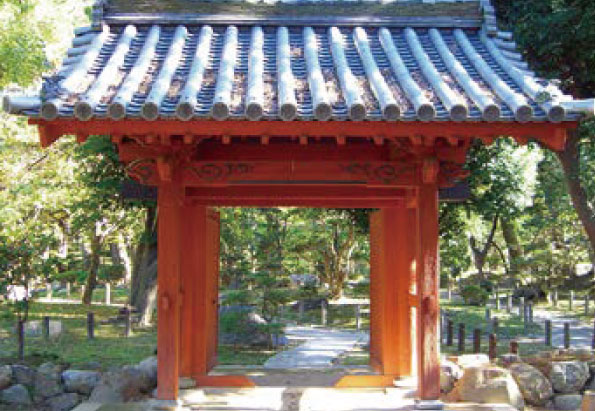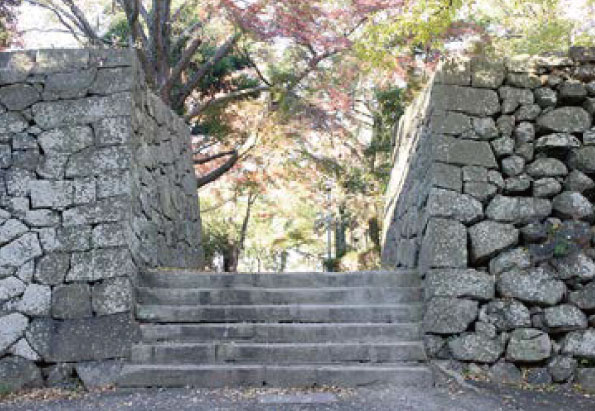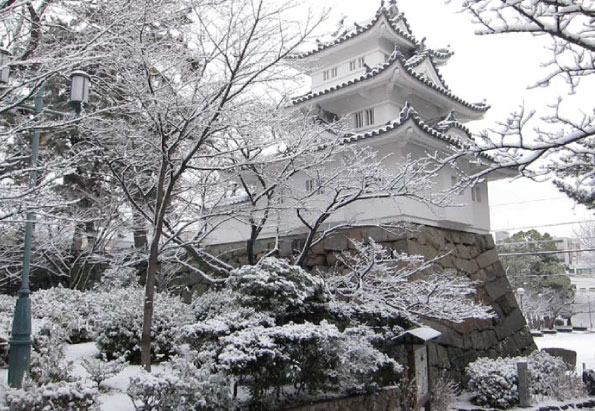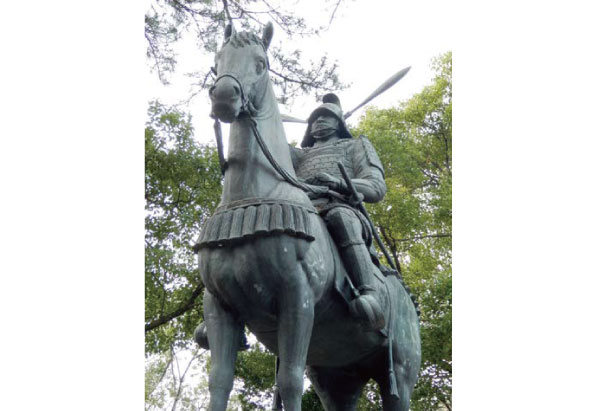Contents
Pg. 2 Sakakibara Onsen (Hot Spring)
Pg. 4 Tage Kitabatake Family Fortified Residence Site
Pg. 9 Tsu City Historical Roads
Pg. 11 Notable People from Tsu
Pg. 1
Historical Townscape
Isshinden Jinaicho
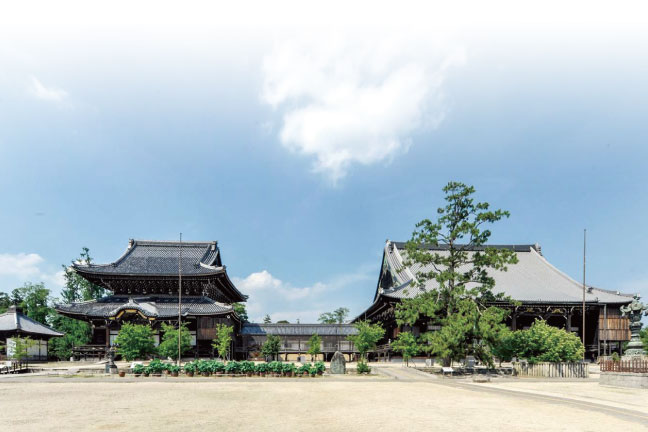
National Treasure Takada Honzan Senjuji Temple
Nyorai-do Hall/Miei-do Hall
On November 28th, 2017, it became the first building in Mie Prefecture to be designated as a National Treasure!
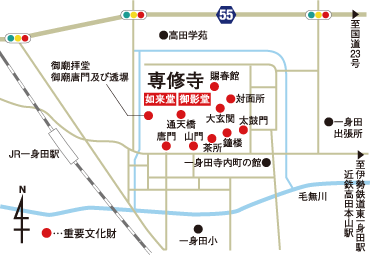
Nyorai-do Hall

Located on the west side of Miei-do Hall. Both halls face south. The object of worship is a standing statue of Amida Nyorai, which is called "Shoko no Nyorai". In the doctrines, this hall is the main hall of the temple.

Left: The boundary between the inner sanctuary and outer area of Nyorai-do Hall. The space between the pillars is wide, and with the differing height of the ceiling, the interior feels spacious. The inner sanctuary pillars, walls and transoms are decorated with gold leaf, creating a magnificent space.
Right: Nyorai-do Hall miniature shrine. A beautiful miniature shrine with gold leaf covering even the smallest areas.
Miei-do Hall

A wooden statue of the sect founder, the holy priest Shinran, is enshrined in the central altar. Images of successive holy priests are placed on either side of the altar and in the space on both sides. With 725 tatami mats, it is an enormous hall, and is the fifth largest wooden building in existence in Japan.

Left: Large front side hall deep in Miei-do Hall's inner area. The ceiling is 8m high. With a reduced number of pillars, it is a large space, in which around 2,000 people can worship at the same time. The lustrous gold of the inner sanctuary pillars and the varied ceiling pictures create a dignified atmosphere.
Right: Miei-do Hall miniature shrine. The shrine doors are decorated with richly colored flowers.
Other sights in Isshinden Jinaicho
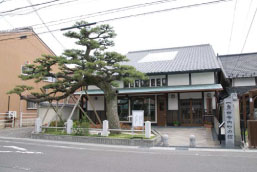
Isshinden Jinaicho-no-Yakata
A facility which introduces the history and culture of Isshinden Jinaicho in an easy-to-understand manner, with photographs and models. It has an exhibition room and rest space and can be used as a base from which to stroll around Jinaicho.
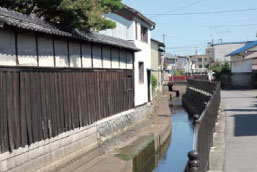
Townscape and moat:
Jinaicho developed around Takada Honzan Senjuji Temple. Today, there are branch temples and merchants' houses lining the streets, and a moat remaining in an almost complete formation. You can see many cultural properties and historical streets in this area.
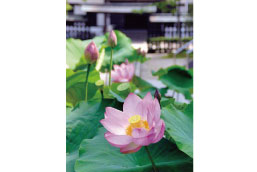
Lotus:
The symbol of Senjuji Temple, lotus flowers are at their best from late July to mid-August.
Pg. 2
Purification region before visiting Ise Shrine
Sakakibara Onsen (Hot Spring)
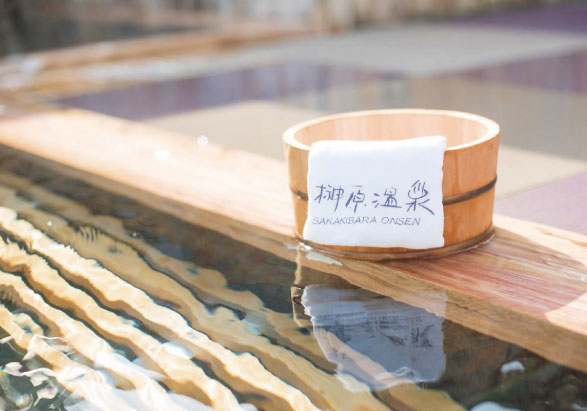
Water has flowed from Sakakibara Onsen for over 1,500 years. It is one of Japan's three most famous hot springs, and was written about as "Nanakuri-no-yu" in The Pillow Book by Sei Shonagon.
It has long been used as a place for many people to purify their bodies and minds before praying at Ise Jingu Shrine.
Sakakibara Onsen facilities
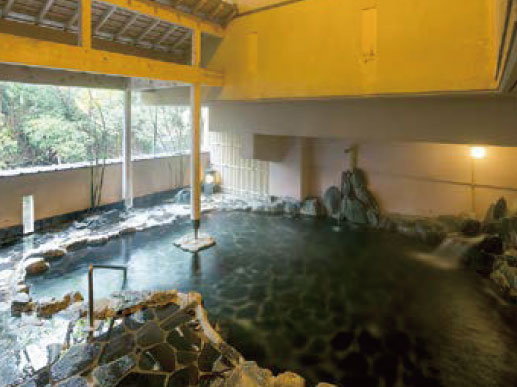
Yumoto Sakakibarakan
Tel: 059-252-0206
The only Sakakibara Onsen which has a water source inside the building.
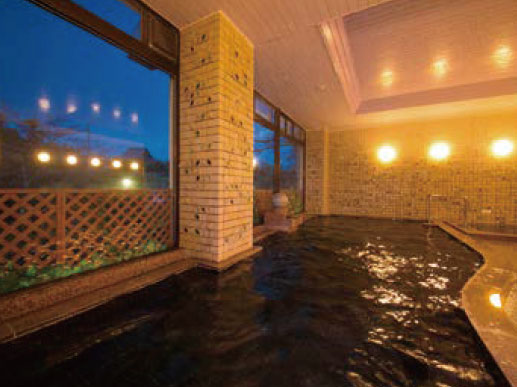
Ryokan Seishonagon
Tel: 059-252-0048
A hot spring inn with a traditional appearance and a peaceful atmosphere.
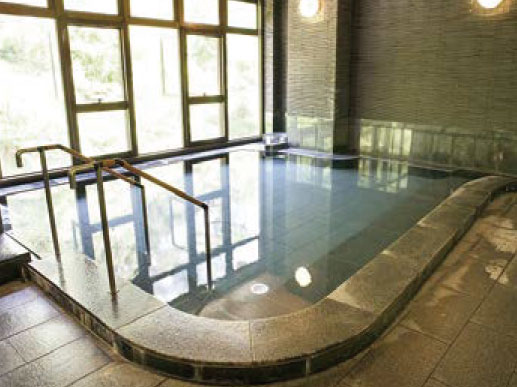
Shintokan
Tel: 059-252-0001
All rooms face the flowing river. From your room you can see the scenery of the four seasons and hear the murmuring of the stream.
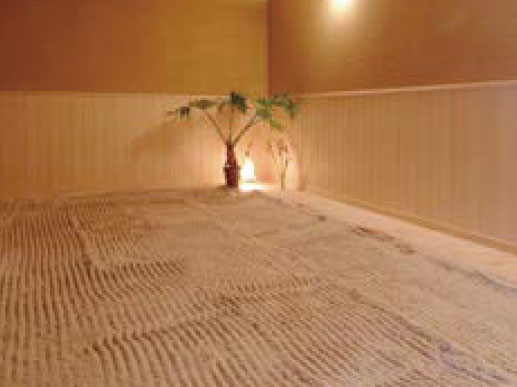
Sand Therapy Sawa
Tel: 059-252-1007
A sand bath relaxation facility in which you can refresh yourself in an ethnic atmosphere in a retro Japanese building.
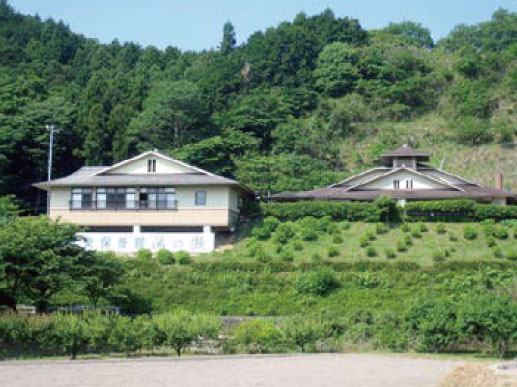
Onsen Hoyokan Yunose
Tel: 059-252-1800
A day trip bathing facility in which you can enjoy a lie-down bath, a tub-type outdoor bath and a box steam sauna.
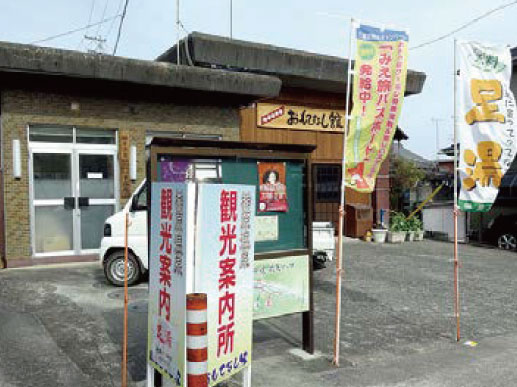
Sakakibara Onsen Promotion Association
5824-1 Sakakibara-cho, Tsu City, Mie
Tel: 059-252-0017
The photograph is Sakakibara Onsen Omotenashikan (Footbath)
Pg. 3
Tsu Jo(Tsu Castle)
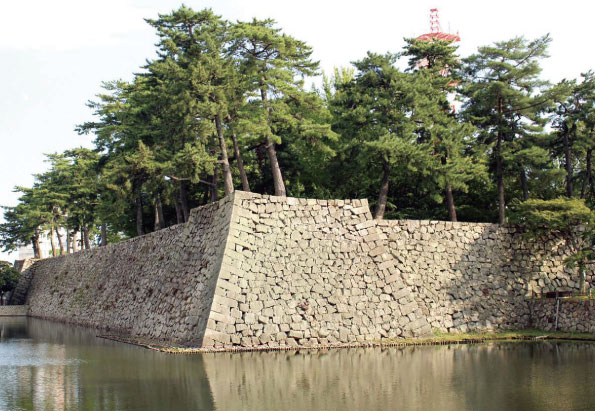
Ranked in the "continued top 100 Japanese castles" series
Selected by the Japan Castle Foundation on April 6th, 2017 (Castle Day).
Tsu Castle was a flatland castle built in 1580 by Oda Nobukane, a younger brother of Oda Nobunaga. In 1608, Todo Takatora entered the castle and integrated it with the surrounding town. Tsu became a bustling post town on the Ise Historical Road.
Pg. 4
Tage Kitabatake Family Fortified Residence Site
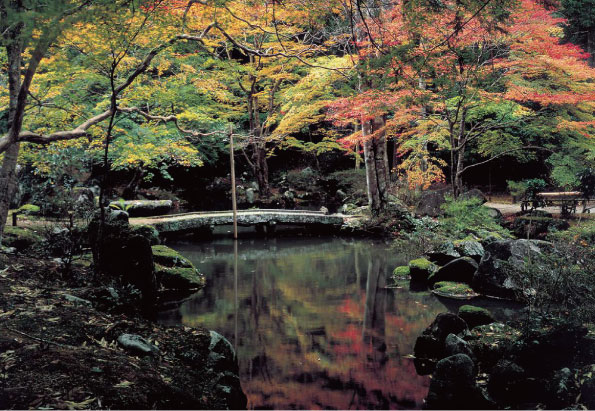
Other sights in Misugi
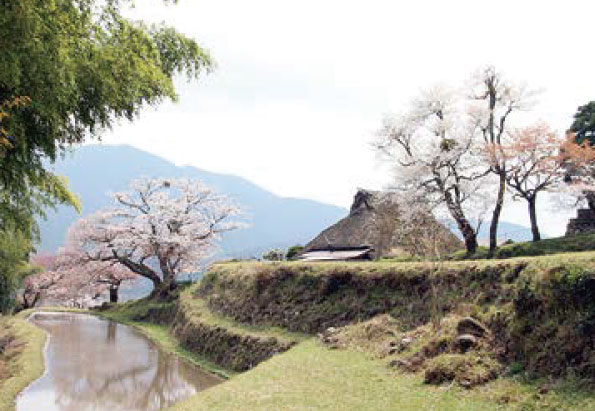
Mitake-no-sakura cherry blossoms
A nationally designated cultural asset, which is one of Japan's top 100 cherry blossom spots. The terraced rice fields full of water and the cherry blossoms in full bloom make a spectacular sight.
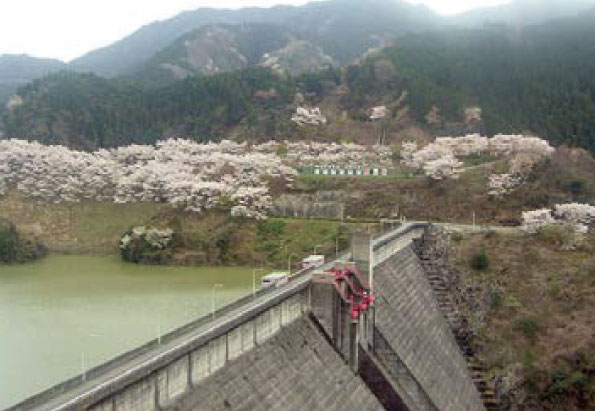
Kimigano Dam
A park with attractive scenes of surrounding cherry blossoms reflected in the water. You can enjoy the beautiful scenery throughout the seasons, such as cherry blossoms, new greenery and autumn leaves.
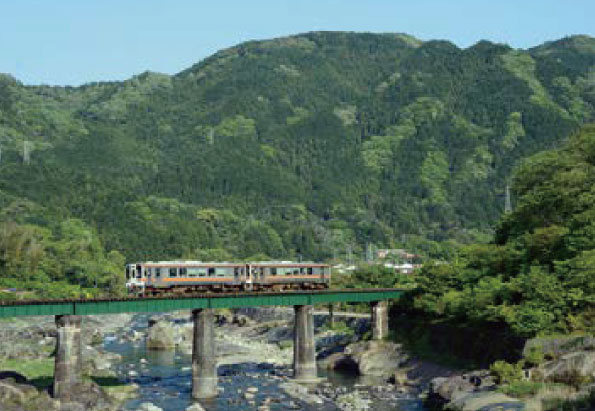
JR Meisho Line
The Meisho Line is a local railway operated by JR Tokai. The changing scenery throughout the seasons charms passengers however many times they ride the train. Along the route are places and items of historical value, which are unknown even to the locals, and must-see spots.
Kawakamisan Wakamiya Hachimangu Shrine
Located at the water source of the Kumozu River, which runs through beautiful mountains and valleys, this is said to be the Kinki area's oldest shrine. There are many prayer events, and large festivals are held in spring and fall.
Nature in Misugi
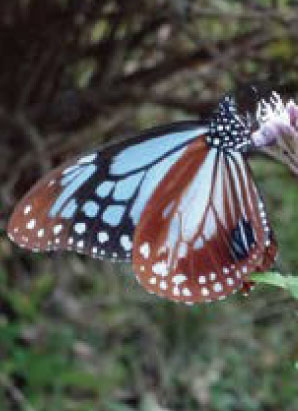
Chestnut Tiger butterfly
The Chestnut Tiger, which crosses the sea, comes to the Misugi region. It can be seen in various locations in Misugi, and we recommend you come to take a look. It often appears from around September to October.
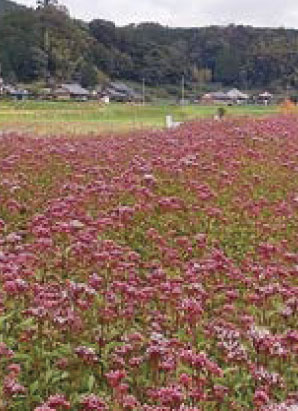
Fragrant eupatorium
At present, flower fields of Fragrant eupatorium, which the Chestnut Tiger butterfly likes, are being expanded. The best time to see them is from the end of September to October.
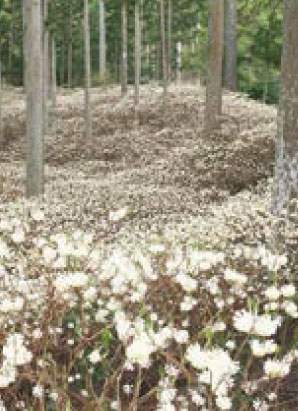
Oriental paperbush
The Oriental paperbush, which grows in the mountain forests of Ishinahara, Misugi-cho, blooms from March to April. The branches divide into three, and yellow flowers blossom at the tips.
Pg. 5
Tsu City East Area
Tsu/Kawage/Karasu
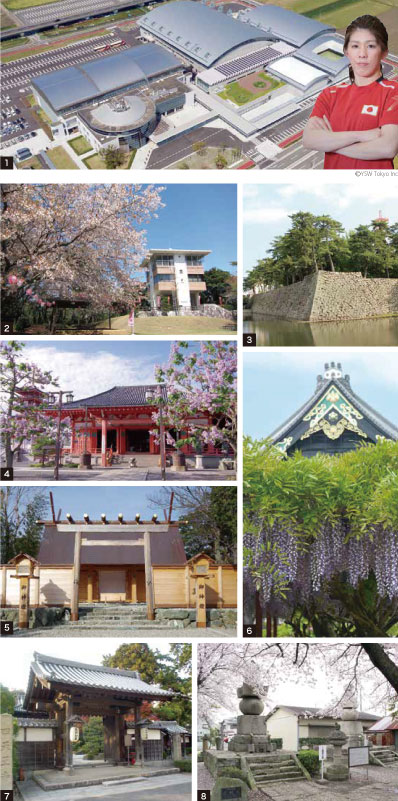
1. Tsu City Industry And Sports Center
Map[D3]
This facility comprises the newly built indoor sports facility "Saorina", "Mie Budokan (martial arts hall)", and "Messe Wing Mie", a pre-existing convention facility which boasts one of the largest sizes in Mie Prefecture. It is the only joint sports and convention facility in the prefecture.
The indoor sports facility was named Saorina after Yoshida Saori, the female wrestler and coach of the female national team, who was born in Tsu City, Mie Prefecture.
2. Ise Ueno Castle Ruins
Map[E-2]
The park (Honjiroyama Seishonen Park) in the Ise Ueno Castle ruins has an athletics field, a multi-purpose area, a strolling area, and a Japanese garden. You can enjoy the park with your family or friends.
An observation platform has been built on the remains of the main enclosure of Ueno Castle. It has panoramic views of the distant Chita Peninsula and Suzuka Mountains, and you can enjoy the scenery throughout the seasons.
3. Tsu Castle Ruins
Map (See enlarged map)
Tsu Castle can be said to be the landmark of Tsu City. It is ranked in the "continued top 100 Japanese castles" series. The castle park is beautifully maintained, and you can enjoy a quiet stroll while gazing at the moat and gardens.
There are two gardens - a delicate Japanese garden and a modern Western garden.
The gardens reflect the seasons, with cherry blossoms in the spring, hydrangeas in early summer, and red leaves in the fall. The most beautiful sight is the contrast between the moss-covered stone walls and the cherry blossoms in spring.
4. Tsu Kannon
Map (See enlarged map)
The official name is Enichizan Kannonji. It is located in the central area of Tsu. The people of Tsu and the local area are fond of the temple, and have referred to it as "Kannon san" for a long time.
It is a temple of the Shingon sect, and along with Asakusa Kannon and Osu Kannon, is one of the three great Kannon temples of Japan.
It holds events, such as the "Oni Osae" Setsubun ceremony and the Toka Kannon. Tsu Kannon Shiryokan museum holds many precious cultural assets, and is open to the public.
5. Karasu Shrine
Map[E-4]
The shrine is dedicated to Wakahirume-no-mikoto, the younger sister of the goddess Amaterasu who is enshrined in Ise's Kotai Jingu (Naiku).
From long ago it has been said that worshipping at Ise Jingu, but not at Karasu Shrine was not complete worship, so the shrine bustled with people.
The prayer hall and the main hall, built in the Shinmei-zukuri style stand in the middle of a pine forest facing the coast of Ise Bay. Visitors today are wrapped gently in a unique Japanese atmosphere.
6. Takada Honzan Senjuji Temple
Map[E-2]
Takada Honzan Senjuji Temple is a designated National Treasure. It is located in Isshinden-cho, near the center of Mie Prefecture. It inherited the teachings of the founder and holy priest Shinran directly. It is affectionately called Takada Honzan.
There are many temples in the grounds of Honzan Senjuji of the Shinshu Takada sect. One of these, Miei-do, is Japan's 5th largest wooden building.
The temple also holds items such as the National Treasure Saihoshinansho, a Buddhist archive of books.
7. Shitennoji Temple
Map (See enlarged map)
One of the four Shitennoji temples built around the country by Prince Shotoku is this Shitennoji Temple in Tsu.
It is also the site of the graves of people associated with Tsu City, including Dota Gozen, Oda Nobunaga's real mother, and Kuhoin, the legal wife of Todo Takatora.
8. Kanshoin Temple
Map (See enlarged map)
In the early Edo period, this temple was called Shosenin. However, the 2nd feudal lord, Todo Takatsugu-ko, changed the name to Kanshoin, derived from the posthumous Buddhist name of Takatora-ko, when Takatora's spirit was enshrined here.
Since then, this temple was treated with importance as the family temple of the domain, and was maintained through domain expenses.
Pg. 6
Tsu City Central Area
Hisai・Misato/Ano・Geino
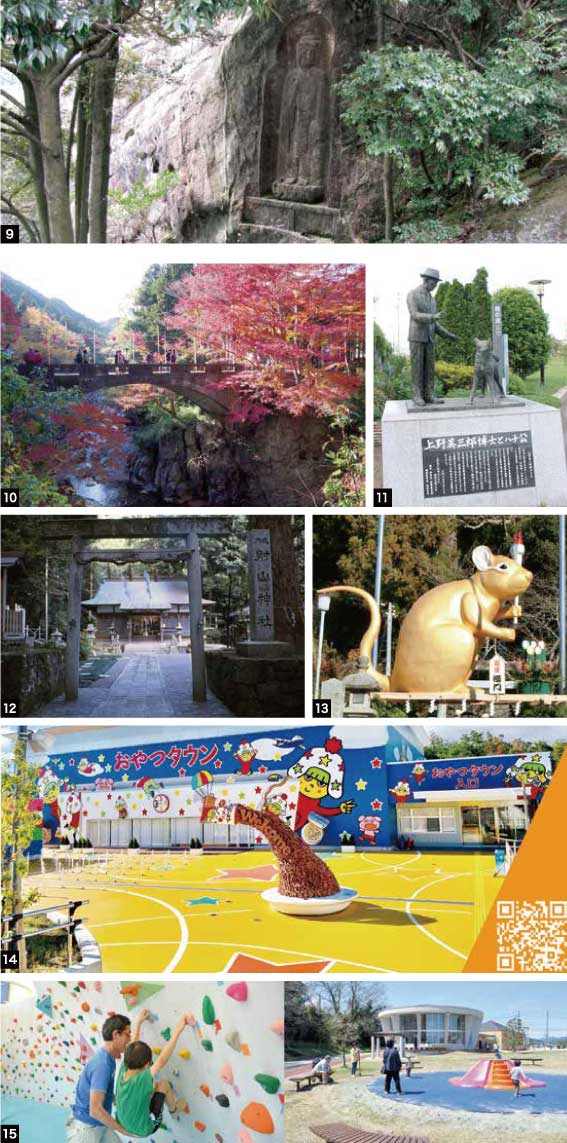
9. Ishiyama Kannon Park
Map[C-1]
Of the Buddhist figures carved into rock faces which are found around the country, this is unmatched in terms of beauty and scale.
The mountain was mostly formed from one craggy rock, and the number of stunning Buddhist figures carved into the rock leaves a lasting and overwhelming impression on visitors.
Around 40 figures are carved into the rock, including Amida Nyorai, Jizo bodhisattva and the 33 Kannon of western Japan. This stunning sight can be seen nowhere else in the prefecture.
10. Kouchi-keikoku Gorge
Map[C-1]
A beautiful gorge in which a clear stream weaves through giant and oddly shaped rocks.
With cherry blossoms in spring, and autumn leaves in fall, you can enjoy the beauty of all the seasons. It is illuminated during the autumn leaf viewing season.
11. Hisai Ekimae Hachiko statue
Map[D-4]
The faithful dog, Chuken Hachiko is famous in Shibuya. Its owner, Ueno Hidesaburo (born in Hisaimoto-machi) was a professor in agricultural engineering at Tokyo Imperial University (present day The University of Tokyo).
Ueno has two graves, one in Hosenji Temple in Hisaimoto-machi and one in Aoyama Cemetery in Tokyo. Hachiko is buried next to Ueno in Aoyama Cemetery. The heart-warming story continues to be told today.
12. Iyama Shrine
Map[C-3]
Therapeutic bathing became popular in the Edo period. During this time, Iyama Shrine, which is dedicated to the god of hot water, was built at Sakakibara Onsen, and it became a large spa.
According to drawings from that time, the spa which used "Miya-no-Yu" holy water from the shrine grounds was large in scale, with 100 guest rooms. Iyama Shrine was known as Onsen Daimyojin, and this continued until the mid-Meiji period.
13. Tatsumizu Shrine (Jumbo Eto)
Map [D-3]
When passing through the sign of the zodiac (eto) for the year, people pray for family harmony, peace for the nation and large harvests. The applicable zodiac sign of the year (12 signs in total) is made by the Furusato Aikokai, and is placed in Tatsumizu Shrine from December 29th to February for people to pass through.
It promotes mountain village culture and helps to invigorate the region, and is a popular local symbol with worshippers.
Oyatsu Town
Map [D-3]
Have you heard of the Baby-Star Ramen theme park Oyatsu Town? It aims to become a much-loved spot in Mie, alongside Ise Jingu Shrine and the Suzuka racing circuit. Making original Baby-Star with your family, friends or loved one adds an extra special memory to your trip. The facility also greatly welcomes visitors who drop in to enjoy the authentic food menu.
15. Geino Wanpaaku
Map[D-1]
A new type of facility for families to enjoy for free, regardless of the weather. It has an indoor exchange plaza and an outdoor grassy area.
It has substantial parking, so you can visit by car.
Enjoy making friends with other parents and refresh your mind and body.
Pg. 7
Tsu City South Area
Misugi/Hakusan/Ichishi
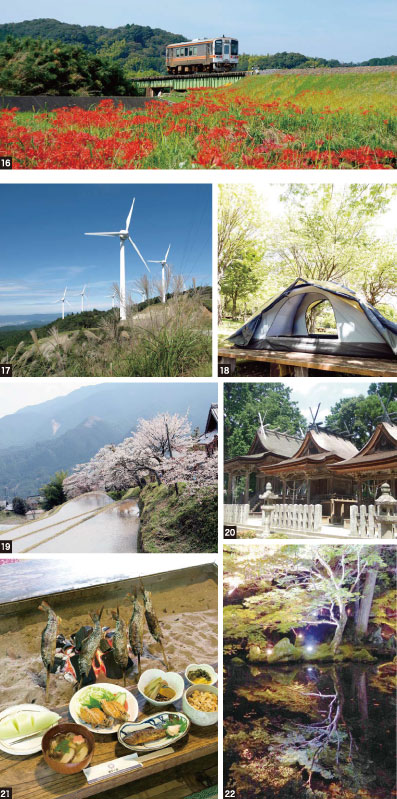
16. JR Meisho Line
Map[B-5]
The JR Meisho Line was completely revived on March 26th, 2016.
The "Miracle Meisho Line" has overcome crisis on many occasions.
It is a local line on which you can take it easy and enjoy the passing scenery of Ichishi, Hakusan and Misugi.
The final stop, Ise-okitsu Station has a rental bicycle service and a tourism exchange facility, so you can enjoy a relaxing trip.
17. Aoyama Plateau
Map [B-3]
Aoyama Plateau forms part of Muro-Akame-Aoyama Quasi National Park. The Aoyama Kogen Koen road and the Tokai Nature Trail run through the plateau.
Japanese andromeda and azalea grow on the gently sloping grasslands from Aoyama Plateau to Mt. Kasatori, and delight visitors.
The triangulation view is stunning, with Iga Basin in the west, and Chita Peninsula in the distance on the other side of Ise Bay in the east.
It is known as the Karuizawa of Kansai, after a summer resort in Nagano. It stretches 15km from north to south, and in summer the temperature is a refreshing 4 degrees lower than the plains.
In May it is covered by colorful azalea, and in the fall by pampas grass.
The summit area spreads across Tsu City and Iga City. In March, 2017, 91 white windmills were installed, and they spin gently in the breeze.
18. Campsites
The appeal of campsites is that they allow you to enjoy getting in touch with nature to the fullest.
There are multiple campsites in Tsu City, especially in the Misugi area. You can enjoy life outdoors as you like, with a choice of campsites at an altitude of 700m featuring panoramic views, and those with bungalows and other facilities.
19. Mitake-no-sakura cherry blossoms
Map[A-6]
The approach from National Route 368 to Shinpukuin Temple gate is around 1.5km in length. It is a famous mountain cherry blossom viewing spot which appears in Mago-uta traditional folksong.
The line of cherry trees is a National Site of Scenic Beauty, and is one of Japan's Top 100 Cherry Blossom Viewing Sites.
A cherry blossom festival is held in April, and it attracts many tourists every year.
20. Shirayama Hime Shrine (Seven shrines of Hakusan pilgrimage)
Map [C-4]
In the Taisho period, it was said that if you worshipped at the seven Hakusan shrines (Yamato, Kawaguchi, Hattaino, Yamadano, Ieki, Takehara and Ibuta) you would get the same benefits as you would by worshipping at Kaga Hakusan. Thus, the shrines bustled with worshippers.
21. Amago cuisine
This red-spotted masu trout is only found in the headstream of rivers.
It is known as the queen of river fish due to its elegant form and shape. Its pleasant, gentle sweetness is rated highly among food specialists.
The Misugi region has a special way of preparing the fish which brings out its beauty and deliciousness to the fullest.
22. Kitabatake Shrine (Garden of the Kitabatake family house remains)
Map[B-6]
The shrine is dedicated to Kitabatake Akiyoshi, the former provincial governor of Ise. It boasts the splendor of the Take palace of Oku-Ichishi.
It has links with the Taiheiki (Chronicle of Great Peace), and in the past, many famous people visited the shrine.
The Garden of the Kitabatake family house remains in the grounds is one of Japan's three major samurai gardens. It is a famous garden of the Muromachi period, with a dry landscape garden and a garden with a path around a pond.
It is a designated scenic spot and historic site, and is famous as an autumn leaf viewing spot.
The Tage Kitabatake Family Fortified Residence Site is ranked in the "continued top 100 Japanese castles" series.
Pg. 8
Tsu Sea
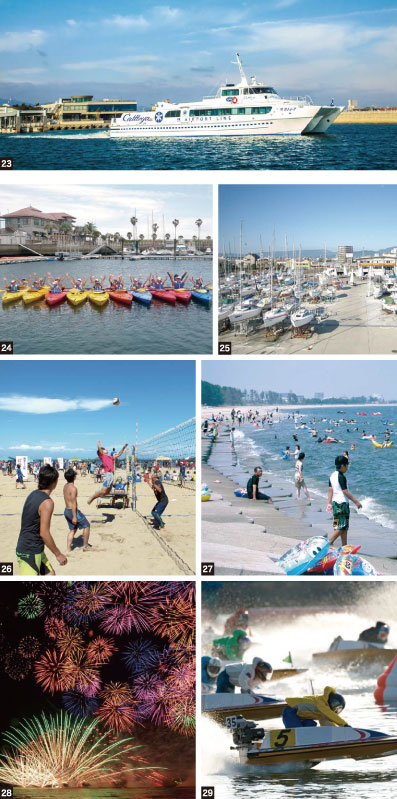
23. Tsu Nagisamachi
Map [E-3]
This was built as an access port to Chubu Centrair International Airport.
High speed ferries run almost every hour between 6:00am and 9:00pm, and reach the opposite coast in around 45 minutes.
BaySeaSky, which is located next to the terminal, has a restaurant and other facilities, and you can enjoy your meal while looking out over the sea.
24. Marina Kawage
Map[E-1]
You can enjoy yachts, motorboats, wind surfing, fishing and other marine sports, along with meals which use fresh ingredients caught in Ise Bay, at this excavation-style marina, which is unusual in Japan.
Water park is also located next to the marina.
Mie Marine Center in the grounds can be used by groups and clubs for summer training and other activities.
25. Tsu Yacht Harbor
Map[E-3]
Kaiyo Sports Center (Tsu Yacht Harbor) is located in the center of Ise Bay coast. Throughout the year, its calm waters are perfect for cruising in the direction of Ise-Shima and the home port of yacht races.
It also has a large boat yard.
There is a sailing area with no birds or reefs.
You can enjoy marine life to its fullest in this center which has facilities and a natural environment.
26. Beach volleyball in Gotemba
Map[E-3]
Every summer, a beach volleyball tournament is held, which creates a lively atmosphere in Gotemba.
The heated battle brings the sea area of Tsu to life.
27. Gotemba Coast
Map[E-3]
The sea area of Tsu is famous for its white beaches and green pines. The coast, stretching approximately 12km, is a designated Prefectural Natural Park. From spring to summer, people go clam gathering and catch fish with their bare hands, and the beaches are packed with families.
Karasu Coast in Karasu-cho is also bustling with people clam gathering and bathing.
28. Tsu fireworks display
Map[E-3]
A summer tradition of Tsu which has continued since the Taisho period.
The highlight is the fireworks over the ocean.
Fireworks are cast into the water one after the other from boats which dash across the sea. It is reminiscent of the splendid sight of peacocks spreading their wings in unison.
29. Boat Race Tsu
Map[E-3]
Tsukki Dome is a conspicuous building from which you can enter and exit on floors one to four. It has a multi-purpose video hall with a shell pattern.
It has a capacity of 673.
The 36 multi-vision screens mounted at the front show the boat race in real time.
It is Japan's first officially recognized boat race place, and dates from 1952.
Pg. 9
Tsu City Historical Roads
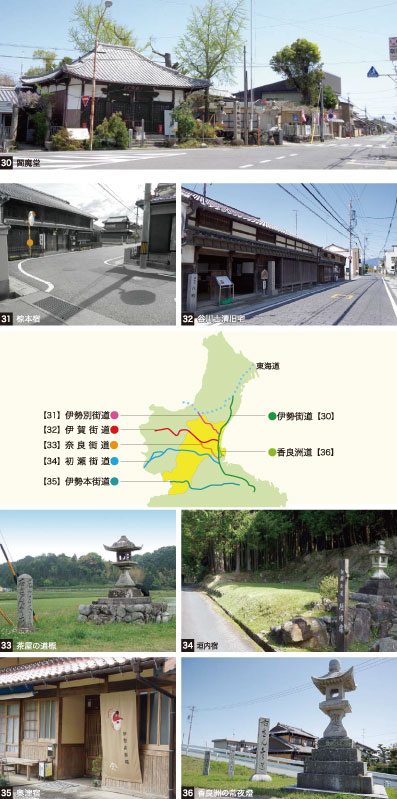
30. Ise Kaido
Map[E-2]
Ise Historical Road goes south along Ise Bay down to Ise Jingu Shrine.
As it is flat, with no steep mountain passes, it was used by many worshippers when praying at Ise Jingu Shrine became popular in the Edo period.
31. Isebetsu Kaido
Map[D-1]
This road connects Sekijuku on the Tokaido road to Edobashi on the Ise Kaido road.
In the Edo period, it bustled with people from the Kyoto area coming to pray at Ise Jingu Shrine. Today, it has lanterns and old houses which bring to mind that time.
32. Iga Kaido
Map[C-2]
This road crosses the Nagano pass, and connects Tsu Castle to Iga Ueno Castle, which were governed by Todo Takatora.
In the Edo period, it was the most important nationally built road of the Tsu domain and was full of people.
33. Nara Kaido
Map[C-3]
The Nara Kaido was established long ago, and in the Middle Ages developed as a connection road between Nara and Ise.
From the start of the Edo period, the number of people using it for mass pilgrimages increased dramatically, and the castle town of Hisai became lively.
Today, the road is 16km long, and runs from Iono, Misato-cho to Tsukimoto, Matsuzaka City.
34. Hase Kaido
Map[C-4]
A road leading to Ise across the Aoyama pass from the Kyoto and Yamato areas.
Compared with the shortest road, Isehon Kaido, this road is flat and easy to walk on, so the area became a popular post town for worshippers at Ise Jingu Shrine.
35. Ise Honkaido
Map[B-6]
The shortest road from Osaka leading to Ise.
Tage (present day Misugi), which was on the route, flourished as the base of Kitabatake, the former governor of Ise, and it became a popular post station town with worshippers going to Ise Jingu Shrine.
36. Karasu Kaido
Map[E-4]
This road branches off Ise Kaido and continues to Karasu. As it was said that without worshipping at Karasu Shrine, a visit to Ise Jingu Shrine is not complete, many worshippers traveled along this road to Karasu Shrine.
If you cross the Kumozu River, it joins the Ise Kaido once again.
Pg. 10
Tsu Festivals
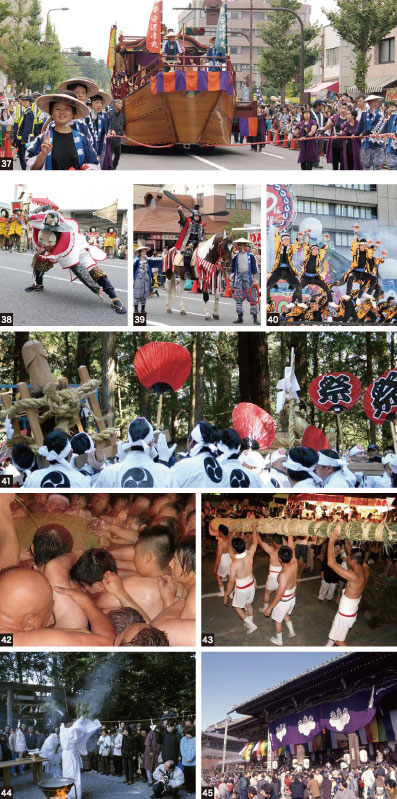
37, 38, 39, 40 Tsu Matsuri
Map (See enlarged map)
Tsu City's largest festival, held every October.
This is a traditional event, which started in the Edo period, and has a history of over 380 years.
The festival features traditional performing arts, including the "Tojin-odori" dance, the "Shagouma" event pretending to be a horse, the "Hachiman lion dance", "Iriewakabayashi" music, "Tsutakatora drumming", and the parading of the "Anotsumaru", a float in the shape of a Japanese boat. In 1998, "Anotsu Yosakoi" dancing was added, and the city comes alive with this festival performed by its citizens.
The Anotsu Yosakoi is a dance which was organized by Junior Chamber International Tsu and began to be performed in Tsu Matsuri in 1998. It was adapted from the YOSAKOI Soran Festival in Sapporo, Hokkaido, and the Yosakoi Festival in Kochi City, Kochi Prefecture. It is an event in which anyone can participate, regardless of age or gender.
41. Gombo Matsuri
Map[C-6]
An unusual festival in which burdock is offered to Nakayama Shrine.
It is known as a bizarre festival, in which people pray for the prosperity of people carrying the portable shrine and use the flathead gray mullet fish to pray for large crop harvests. (Every February 11th)
42. Zaruyaburi Ritual
Map[E-2]
The hadaka matsuri of Isshiki Yagumo Shrine, with a history of around 400 years.
On the signal of a firework bang, men, dressed only in loincloths, scramble over each other, creating a dynamic sight. (Every July 15th)
43. Yabuneri
Map[E-2]
Yabuneri is held in the summer festival of Yagumo Shrine, Shiratsuka-cho. Yabu, which are bundles of bamboo representing Yamata-no-Orochi, the dragon slayed by the guardian deity Susano-o-no-mikoto, are paraded around the streets. It is an energetic event, in which people pray for the expulsion of sickness. (Every July 11th)
44. Miyu (Yudate Shinji:Boiling water ritual)
Map[C-3]
Hot spring water and water for longevity is mixed and boiled, and the water is sprinkled on worshippers with bamboo grass to pray for good health. (Every February 11th)
45. Oshichiya
Map[E-2]
A memorial service for the holy priest Shinran. It is conducted over seven days and nights, from January 9th to 16th.
Street stalls line the road in front of the gate of Shinshu Takada-ha Honzan Senshuji Temple, and every year over 100,000 people visit.
Pg. 11
Notable People from Tsu
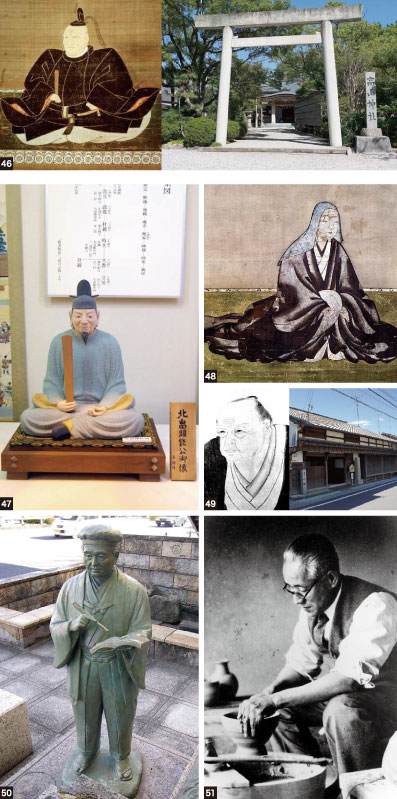
46. Todo Takatora (Kozan Shrine)(1556-1630)
Map (See enlarged map)
Todo was born in Todo Village, Omi Province (present day Kora-cho, Shiga Prefecture) in 1556. He was a military commander in the Warring States period. He was known as a master of castle-building and as a strategist, and served seven lords in his lifetime.
He contributed to the victory of the Eastern Army in the Battle of Sekigahara, and thus became a daimyo lord with 200,000 koku (unit of volume) worth of land. After that, he moved from Imabari, Iyo Province (present day Imabari City, Ehime Prefecture), to Ise, Iga Province. He repaired Tsu Castle and developed the foundations for the town of Tsu.
47. Kitabatake Akiyoshi(Unknown - 1383)
From the Nanboku-cho period, he was based in Tage. He was the first governor of Ise and wielded power over the region.
He is said to have moved his base to Tage (present day Misugi-cho, Tsu City) after the fall of Tamaru Castle.
After that, Akiyoshi was the central force in the South dynasty here in Tage.
48. O-Go(1573-1626)
The youngest of three daughters who were born between the warlord Azai Nagamasa and Oda Nobunaga's younger sister, O-Ichi.
It is written in the document Oda Gunki, vol. 13, that after the fall of Odani Castle in 1573, O-Go, along with her mother and two sisters (Chacha and Hatsu), were left in the care of Oda Nobukane. It is said she lived in Ise Ueno Castle until 1582 when Oda Nobunaga died in the Honno-ji Incident.
49. Tanigawa Kotosuga(1709-1776)
Map (See enlarged map)
Tanigawa was a doctor, who also wrote many books. Along with Motoori Norinaga, he is one of Japan's most prominent classical scholars.
His most famous works are Nihon Shoki Tsusho, which explains the Nihon Shoki (ancient chronicles) in an easy-to-understand manner, and Wakun-no-Shiori, which was Japan's first dictionary in the order of the Japanese syllabary.
50. Nishijima Hachibee(1596-1680)
Born in Hamamatsu City, and served as an attendant to Todo Takatora.
He displayed a talent for map-making, reservoir building and land development. He developed Owada-shinden and Kumozu irrigation channels, thus supporting the Tsu domain through water supply and irrigation.
This bronze statue is located in the Marunouchi shopping area.
51. Kawakita Handeishi(1878-1963)
Handeishi was a name given to him by his Zen teacher. It means one has to devote oneself to something and get muddy, but still be able to look at oneself calmly.
His days were filled with his varied hobbies including calligraphy, tea ceremony, haiku and photography. One of his activities, making ceramics, became more than a hobby, and was rated so highly that Rosanjin in the East, Handeishi in the West, became a phrase.
Pg. 12
Tsu Museums
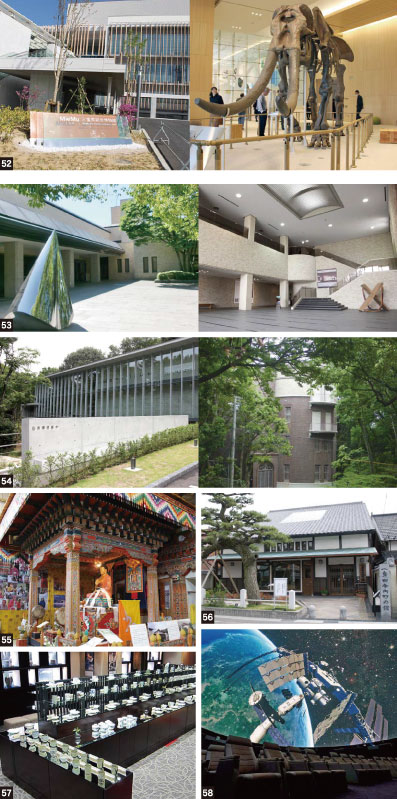
52. Mie Prefectural Museum MieMu
Map (See enlarged map)
Holds natural science specimens, archaeological objects excavated from around the prefecture, and Yayoi pots.
In the rear garden is a restored Torii burial mound, so you can see such a mound which has a stone burial chamber.
The museum holds special exhibitions, basic exhibitions and events throughout the year.
059-228-2283
53. Mie Prefectural Art Museum
Map (See enlarged map)
The permanent exhibitions are divided into four term throughout the year. With a focus on modern Japanese painting, it aims to show the changes in art systematically, leading to the present day.
In the special exhibition room, it holds independent exhibitions with unique themes, and joint exhibitions with a broad perspective.
059-227-2100
54. Sekisui Museum
Map[E-3]
The museum displays items with a focus on the old possessions of the Kawakita family, who were wealthy Ise merchants in the Edo period. They cover a wide range of fields and include tea ceremony items, calligraphy, Western paintings, old classical books, color woodblock prints and historical documents related to Ise merchants.
You can enjoy viewing the items collected by successive heads of the Kawakita family, and masterpieces by Kawakita Handeishi, who was known as a ceramic artist. The museum also holds special exhibitions.
059-227-5677
55. Higuchi Yuko Museum
Map[E-2]
The museum displays items from the Australia pavilion, and the Bhutan and Laos pavilion of the 2005 World Exposition held in Aichi.
In the Australia pavilion, visitors are greeted by the hugely popular giant model of a platypus named Kamon.
In the Bhutan and Laos pavilion, you can experience traditional Buddhist culture.
An exhibition of items from three countries of the World Exposition is unusual in Japan. The name "Yuko", which means friendship, suits the museum.
059-232-3075
56. Isshinden Jinaicho-no-Yakata
Map[E-2]
Isshinden Jinaicho is a historical temple town which developed around Takada Honzan SenjujiTemple, and has continued to exist since the Warring States period.
Today, it has many cultural assets and boasts a historical townscape. There is a moat running around the outside of the town in an almost complete form, which was built for drainage and to protect from outside enemies.
Isshinden Jinaicho-no-Yakata, the base for a stroll around the town, is a two-minute walk from Senjuji Temple.
It introduces the history and culture of Jinaicho through photographs and reconstruction models, and distributes free guide maps. It also accepts applications for a free walking tour with a volunteer guide. (Reservations must be made up to 10 days in advance.)
059-223-6666
57. Hironaga-gama Gallery
Map (See enlarged map)
Has a wide range of objects, from one-of-a-kind works made by artisans to everyday items.
Works by Kawakita Handeishi and Tsuboshima Dohei are displayed in Gallery Senkaku.
The café at the gallery has a relaxing atmosphere, and you can enjoy coffee or matcha green tea served in ceramics made from Handeishi Hironaga-gama ware.
Enjoy a relaxing time here.
059-221-7120
58. Kagura Dome
Map (See enlarged map)
Okasan Digital Dome Theater (Kagura Dome) was built in October 2013 as part of the 90th anniversary of the founding of Okasan Securities Group project. It began full-scale operations the following April.
Uniview was developed jointly by three countries - The USA (American Museum of Natural History), Sweden (SCISS AB) and Japan (Orihalcon Technologies, Inc.). It is state-of-the-art interactive space imagery software.
059-221-3121
Pg. 13, 14
Tsu Cuisine and Souvenirs
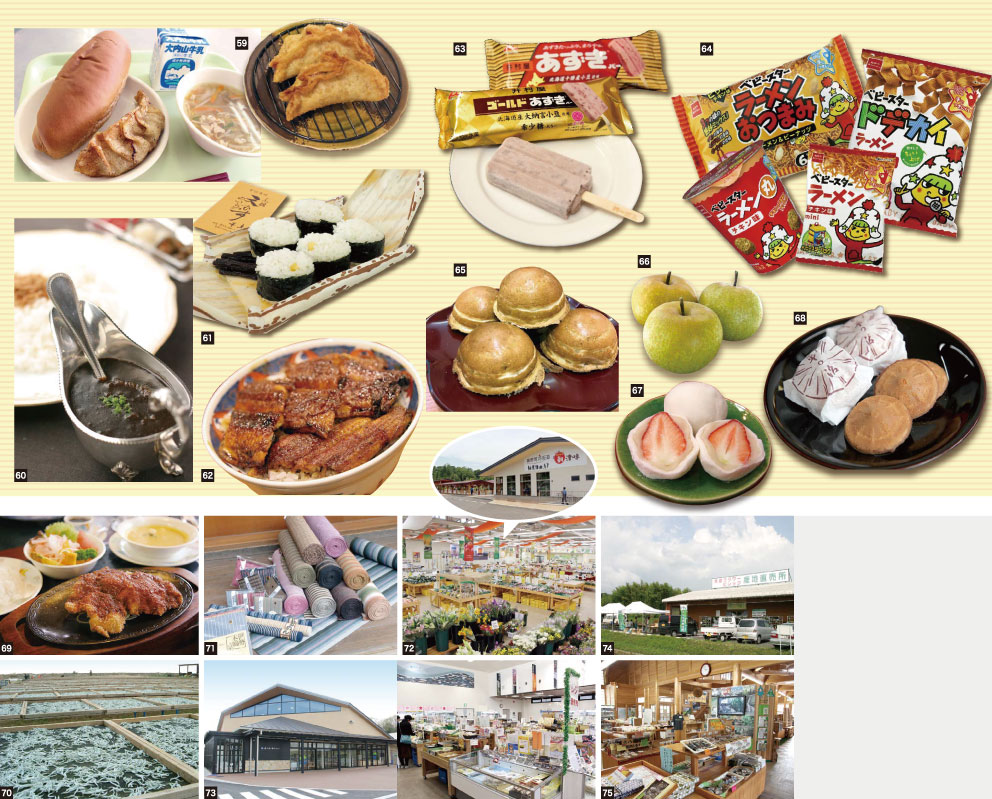
59. Tsu Gyoza
A local specialty which began as part of school lunches in Tsu.
These dumplings are wrapped in a large 15cm-diameter skin, and are deep-fried.
They are the most popular item on the school lunch menu.
You can try them at over 20 places in the city, including restaurants, izakaya-style pubs, and hot spring inns. The citizen group "Tsu Gyoza Elementary School", which revitalizes the city through Tsu gyoza dumplings, won the gold grand prize in the B-1 Grand Prix, a local food contest, held in Akashi.
60. Black curry
Black curry from the long-established Western-style restaurant Toyoken is made with Matsusaka beef. It is an unusual "deep-black curry".
It takes time, effort and diligence to make the curry, which has a profound taste.
61. Tenmusu (rice ball with tempura shrimp filling)
Tenmusu is a Tsu City specialty, which began when a proprietress of a restaurant cut nutritious deep-fried Kuruma shrimp and put it inside a rice ball for her busy husband.
62. Eel
Eel from Tsu is loved so much by the people of the city that Tsu boasts the highest consumption volume in Japan.
There are many specialty eel restaurants in Tsu, and you can enjoy rich Kansai style eel dishes here.
Each restaurant has its own secret flavoring, and in addition to Kabayaki (glaze-grilled eel), you can sample omelet-wrapped eel (umaki), and eel and cucumber vinegared dish (uzaku).
63. Azuki Bar (Imuraya Seika)
A hugely popular ice cream from Tsu, this is a staple in summer. In winter, the company's steamed meat buns and steamed bean buns are standard items.
64. Baby-Star Ramen (Oyatsu Company, Ltd.)
A standard snack which the founder created when he saw fragments of leftover noodles when making instant ramen.
Oyatsu Company has its headquarters and factory in Tsu City. Its products are popular with young children, not only for their taste and price, but also for their originality.
65. Hachimitsuman (Steamed bun with honey)
A specialty sweet bun which was created by the first owner of the Mizutani honey company with the idea of bringing honey into people's lives.
Put a freshly made steamed bun in your mouth, and enjoy the sensation of the crispy skin, the steaming bean jam, and the gentle spreading flavor of honey.
Sold at a reasonable price and easy to eat, it is the soul food of Tsu.
66. Nashi pear
Map[E-2]
The farmer's stores in Hisai and Karasu are a common sight in summer.
67. Ichigo Daifuku (Strawberry rice cake)
Ichigo Daifuku is famous as a Tsu City specialty. It is stocked by many well-known confectioners in the city.
68. Heiji Senbei (Crackers)
An egg senbei made by an old production method cultivated through history and tradition. It is made in the shape of a straw hat, which the famous Heiji of the Akogi Heiji legend forgot.
69. Miso-katsu (Pork cutlet with miso)
Miso-katsu was created with the idea of making a Western-style dish which would taste familiar to Japanese people.
It is often associated with Nagoya, however it was created in 1965 by Kaindokokku-no-Ie Katorea, a restaurant in Tsu.
The taste of miso in a Western-style restaurant is superb.
70. Kounago
Kounago is the name for the young fish of the Japanese sand lance.
It is cooked in a pot, sun-dried, and simmered in soysauce, sugar and ginger.
Fishing begins at the end of February, and Kounago from Shiratsuka, which is raised in the abundant, rich sea of Ise Bay, is famous throughout Japan, and highly nutritious.
Various other kinds of seafood are processed and sold in Shiratsuka.
71. Ise Cotton
Traditional textiles with a history of a few hundred years.
Made with soft yarn, it is difficult to crease, and is gentle against the skin. It retains moisture and is highly breathable, making it perfect for gifts, souvenirs or everyday life.
Recently, the Ise Cotton wearing experience has become popular.
72. Asatsumi
Map[D-1]
This farmer's market opened in July, 2016. It sells local fresh and delicious fruit and vegetables.
It also has a gardening section, which sells seasonal flowers and unusual plants. The adjoining cultivation park Red Hill "The Forest of Hisa" is also a great place to visit.
73. Michi-no-Eki Tsukawage
Map[E-1]
This roadside station opened on April 24th, 2016.
It is a convenient spot with produce from the sea, mountains, and Tsu.
74. Misato Flower Village
Map[C-3]
This farmer's market has an abundant array of fresh, local agricultural produce, including seasonal cut flowers and seedlings, and freshly cultivated vegetables and eggs.
75. Michi-no-Eki Misugi
Map[B-6]
A roadside station which is barrier-free, people-friendly and built of wood.
In addition to selling and displaying Misugi wood, and selling local specialties from the Misugi region, it also serves meals and soft ice cream.
It is used as a rest spot for tourists using National Route 368, Ise Honkaido, the forest therapy course, and Kitabatake Shrine.
Pg. 15, 16
Tsu Flowers and Nature
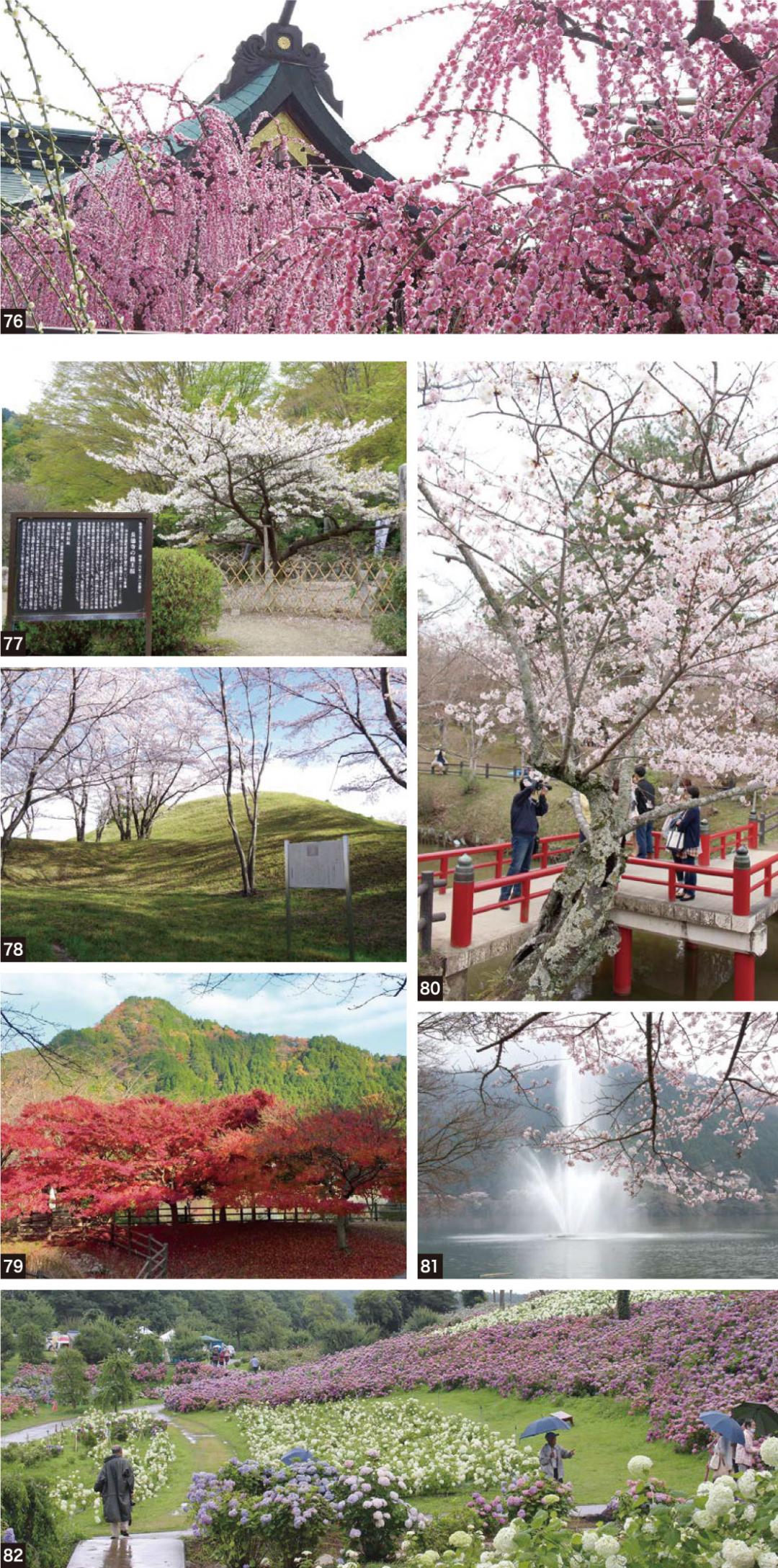
76. Yuki Shrine (Plum blossoms)
Map[E-3]
Yuki Shrine is dedicated to Yuki Munehiro-ko, who contributed to the establishment of the Kenmu Restoration under Emperor Go-Daigo.
It has long been known as the Forest of Yuki, and has been called and referred as Yuki zuka and Yuki Myosin.
It is the site of the grand tombstone of Yuki Munehiro-ko, and is famous for its beautiful weeping plum trees.
77. Chotokuji Temple (Ryuo sakura cherry blossom tree)
Map[C-1]
It is said that when the dragon which lived in the deep pool in front of the temple climbed to heaven, it left behind scales and cherry blossom seeds. These seeds grew into a Ryuo cherry blossom tree.
It is a designated Natural Monument of Mie Prefecture.
78. Akeai Kofun (Cherry blossoms)
Map[D-2]
The main tumulus of Akeai Kofun burial mounds is a nationally designated Historic Site. It is the largest chief tumulus in the Ano River basin dating from the first half of the 5th century. No burial mounds of this scale and shape have been constructed in Mie Prefecture since, which makes it worthy of much attention when considering the prefecture's burial mound culture.
Also, Ano Chuo Sogo Park has beautiful cherry blossoms and large green hilly spaces with a sense of openness. The continuing flowing water makes it an attractive wide area.
It has wooden playground equipment and a grassy space, so all the family can enjoy the park.
79. Lake Shakujo (Autumn leaves)
Map[C-1]
A beautiful dam lake which is at the source of Ano River. Lake Shakujo is in the middle of many cherry blossom trees, and the facility Shakujo Kosuiso stands on its banks.
You can relax in accommodation surrounded by the lake and mountains and enjoy a quiet time to yourself. You are also sure to be satisfied with the delicious cuisine.
How about relaxing at Shakujo Kosuiso while enjoying the waterside scenery?
80. Tsu Kairaku Park (Cherry blossoms)
Map (See enlarged map)
A long time ago, it was called Gosan-so or Gosan-so-yama. It began when the 11th lord of the Tsu domain Todo Takayuki-ko built a villa in the Ansei period (1854-1860).
Kairaku Park comes from the pen name of Lord Takayuki.
It has natural hills and valleys, and in spring, cherry blossoms and purple azaleas bloom. In the fall, the park is full of the beautiful colors of autumn leaves.
81. Kimigano Dam Park (cherry blossoms)
Map[B-5]
You can enjoy scenery throughout the seasons, with cherry blossoms in spring, new greens in summer, autumn leaves in the fall and snowy landscapes in winter.
The spring cherry blossoms and the fountain reflected in the dam lake is a breathtaking sight.
The dam lake is full of color in spring with 1,500 cherry blossom trees, and in fall with the autumn leaves.
82. Kazahaya-no-Sato (Plum blossoms, wisteria, hydrangeas)
Map[D-3]
The flower garden "Kazahaya-no-Sato" - Kappa-no-Furusato - integrates welfare and the environment. It is in the middle of the 70,000㎡ hilly Ise Onsen Golf Club, on the banks of Kazahaya Pond, which has a circumference of 8km. It is connected to Todo Takatora and the temporary castle of Oda Nobukane in battle.
Gardening is performed daily on the 650 plum blossom trees, 1,800 wisteria trees and the 75,000 hydrangea shrubs.
It is Japan's first garden and welfare flower park, and beautiful flowers bloom in spring, summer and winter. You can enjoy the relaxing flower scenery in this integration between welfare and the environment.
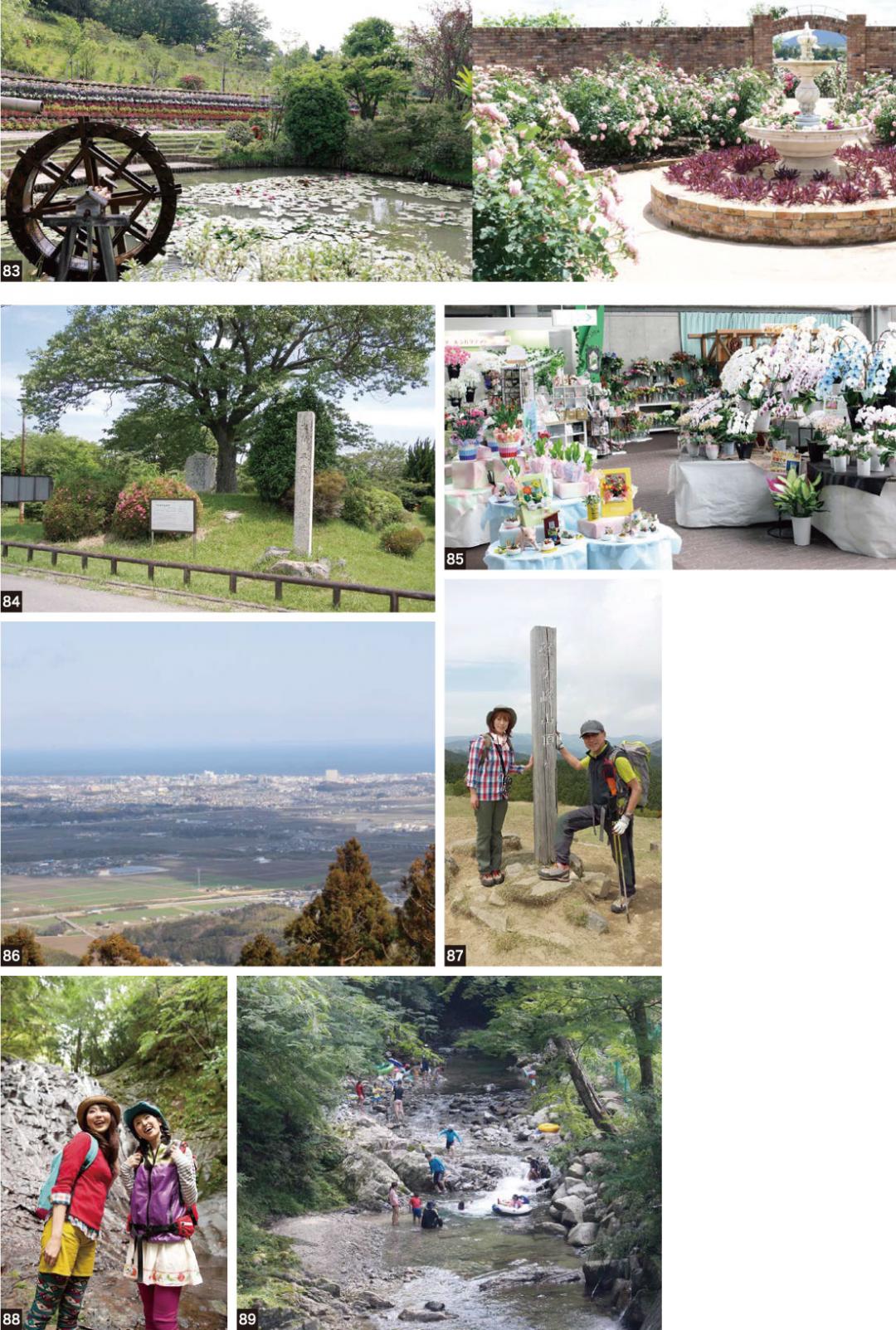
83. Red Hill "The Forest of Hisa"
Map[D-1]
A woodland where you can enjoy over 10,000 flowers and trees of 1000 varieties, centered on rhododendrons.
The area is around 60,000㎡ in size. In a "forest area", it has coastal redwood, the world's tallest trees, and the hills and fields, and in a "flower area", it has an attractive pond with a blooming rose garden and water lily. You can feel the magnificence of nature here.
84. Tadamorizuka (Legendary birthplace of the Ise Taira clan)
Map[D-3]
The origin of the Ise Taira clan, known officially as the legendary birthplace of the Ise Taira clan.
It is said that this is the burial place of the placenta of Taira no Tadamori, the father of Taira no Kiyomori. The pond where it is said that Tadamori took his first bath remains here.
85. Akatsuka Botanical Garden
Map[D-2]
This large botanical specialty store proposes and sells plants throughout the seasons.
It holds events such as horticulture workshops and planting classes. On the farm where rhododendrons and roses are cultivated, the Akatsuka Rhododendron Garden is open to the public for a limited time.
86. Mt. Hase
Map[D-3]
A single peak low mountain with an altitude of 320m. It spans Misato-cho and Ano-cho in Tsu, and the old Tsu City.
It has views of the center of Tsu City and the coast. Behind Mt. Hase is Mt. Kyogamine to the right, and Aoyama Plateau and Nunobiki mountains to the left.
There are many walking courses, which all have gentle slopes. As the summit can be reached in an hour, the mountain is loved by the local people.
87. Mt. Kyogamine
Map[C-2]
Mt. Kyogamine has an altitude of 819m. There are climbing trails, and a wooden observation platform at the summit.
Aoyama Plateau, Mt. Kasatori, Ise Bay and Atsumi Peninsula spread out below, and Mt. Fuji can be seen.
88. Forest therapy base
A relaxing space in the suburbs of the city. There are 12 therapy roads which have beautiful natural features such as rich green forests and pure clear streams. A stroll along these roads will calm your mind.
Recently, Nordic walking has become popular.
89. Mountain streams
In Misugi-cho, there are many places where you can enjoy the clear forest air and natural and rich mountain streams.


